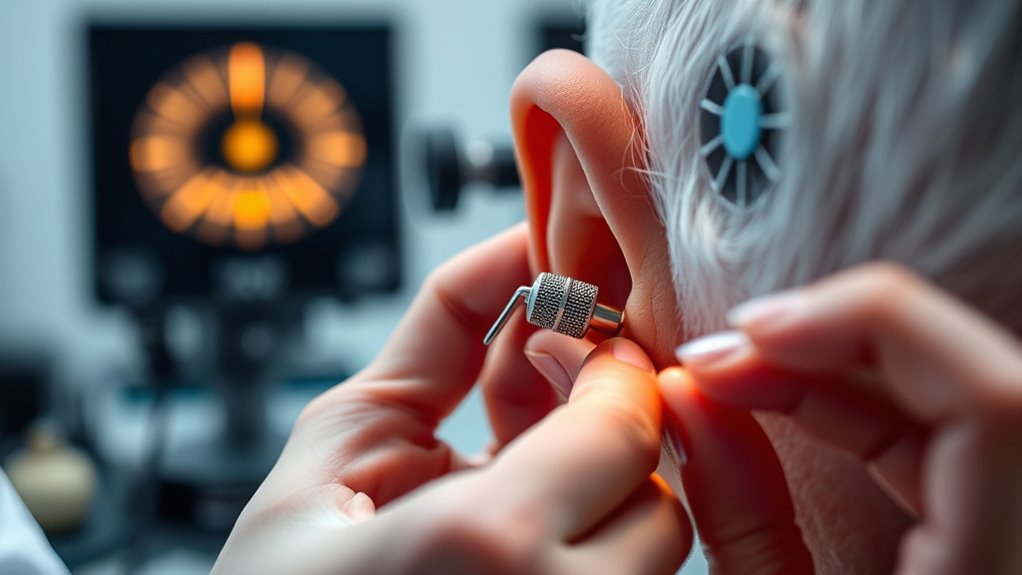Real-ear measurement (REM) is essential because it guarantees your hearing aids are properly calibrated to your unique ear shape and hearing needs. By measuring how sound travels inside your ear, it helps tailor the device’s amplification for natural, comfortable listening. REM verifies that the hearing aids deliver the correct sound levels across frequencies, improving performance and reducing listening fatigue. If you want to understand how this process can optimize your hearing experience, there’s more to discover.
Key Takeaways
- REM verifies that hearing aids deliver the correct amplification tailored to individual ear anatomy.
- It ensures hearing devices are accurately calibrated to meet prescribed target listening levels.
- Performing REM confirms optimal device performance in real-world listening environments.
- REM helps identify and correct issues like under- or over-amplification for better sound quality.
- It enhances user comfort and speech understanding, improving overall hearing aid effectiveness.

Have you ever wondered how audiologists guarantee hearing aids fit perfectly and provide ideal sound quality? The answer lies in a process called real-ear measurement (REM). This technique is essential for ensuring your hearing aids are calibrated accurately and tailored specifically to your hearing needs. When your audiologist performs REM, they use specialized equipment to measure how sound waves travel inside your ear canal with the device in place. This process allows them to fine-tune your hearing aids so they deliver the correct amplification across different frequencies, ensuring you get the most natural and comfortable listening experience.
Real-ear measurement ensures your hearing aids are precisely calibrated for natural, comfortable sound quality.
Hearing aid calibration is a critical step that relies heavily on these precise measurements. Unlike generic settings, REM allows your audiologist to verify whether the hearing aids are providing the intended amplification based on your unique ear anatomy. Without this step, there’s a risk that your device might be under- or over-amplifying certain sounds, leading to discomfort or poor speech understanding. By conducting real-ear measurements, your audiologist can adjust the device’s output to match the prescribed target levels, which are determined through detailed hearing tests.
Custom fitting techniques complement this process by ensuring the physical fit of your hearing aids is just right. The shape and size of your ear canal influence how sound propagates, so a snug, comfortable fit is crucial for optimal performance. During the fitting, your audiologist may use impressions or 3D scanning to create a device that conforms precisely to your ear’s contours. This customization not only enhances comfort but also maximizes the effectiveness of hearing aid calibration. When combined with REM, these custom fitting techniques allow for a comprehensive approach to personalization, addressing both the physical fit and the acoustic performance.
Performing REM after fitting your hearing aids ensures they function as intended in real-world listening environments. It verifies that the device’s output matches the targets specified in your hearing profile, allowing for adjustments if needed. This process is especially important because it accounts for variables like ear shape, ear canal resonance, and individual listening preferences. The result is a tailored hearing solution that feels natural, sounds clear, and reduces listening fatigue.
In essence, real-ear measurement is a vital step that bridges the gap between fitting a hearing aid and optimizing its performance. It guarantees that your device is calibrated accurately, complements custom fitting techniques, and delivers the sound quality you need for better communication and improved quality of life. Without it, even the most advanced hearing aids may not reach their full potential.
Additionally, these measurements help improve device longevity by ensuring the hearing aids are functioning optimally and reducing unnecessary strain on electronic components.
Frequently Asked Questions
How Often Should Patients Have REM Performed?
You should have REM performed at least once a year, following general frequency guidelines, to guarantee your hearing aids are functioning properly. Regular checks help maintain ideal performance and address any changes in your hearing. Consistent REM also boosts patient compliance, as it confirms your devices are tailored to your current needs. If you notice any issues, schedule an appointment sooner to keep your hearing aids working effectively.
Can REM Be Done With All Hearing Aid Brands?
Yes, REM can be done with most hearing aid brands, but brand variability may affect measurement accuracy. Some brands have custom tools or compatibility features that make REM easier and more precise. To guarantee the best results, check if your hearing aids support REM testing and work with a provider experienced in your specific brand. Accurate measurements are vital for maximum hearing aid performance, regardless of the brand.
Does REM Improve Overall Hearing Aid Satisfaction?
Think of REM as the secret ingredient for better hearing. It directly improves fitting accuracy, making sure your hearing aids are tailored just for you. When your device fits perfectly, your confidence in hearing clearly skyrockets. As a result, you’re more satisfied with your hearing aids because they perform as expected. REM helps bridge the gap between expectation and reality, turning good hearing into great hearing.
Are There Any Risks Associated With REM?
There are minimal risks associated with REM, especially when performed by trained professionals. It helps guarantee patient safety by confirming your hearing aid is properly calibrated to your ear. Incorrect calibration or equipment issues can lead to discomfort or less effective hearing, but these risks are rare. Regular equipment maintenance and professional oversight ensure REM remains a safe and valuable process, ultimately improving your hearing aid performance and satisfaction.
How Does REM Impact Long-Term Hearing Aid Adjustments?
REM directly impacts your long-term hearing aid adjustments by ensuring customization precision, which helps your device fit and sound just right. When adjustments are based on REM data, you experience better clarity and comfort over time. This process allows your audiologist to fine-tune your hearing aids to match your evolving needs, enhancing patient comfort and maintaining ideal performance long-term.
Conclusion
Now that you know about real-ear measurement, you understand how vital it is for personalized hearing solutions. Did you know that over 60% of hearing aid users benefit considerably more when their devices are fine-tuned with REM? This statistic shows just how much precision can improve your hearing experience. By prioritizing REM, you’re ensuring your hearing aids deliver the best sound quality possible, helping you stay connected and confident every day.











